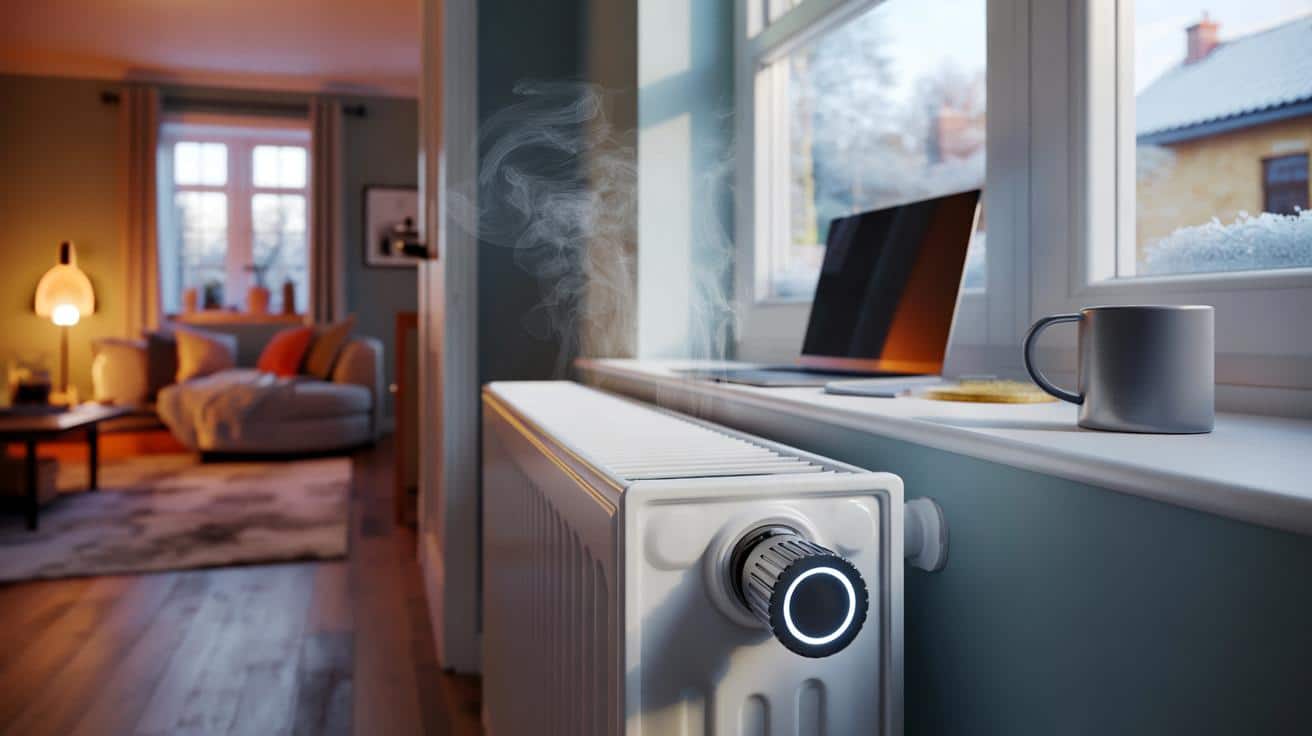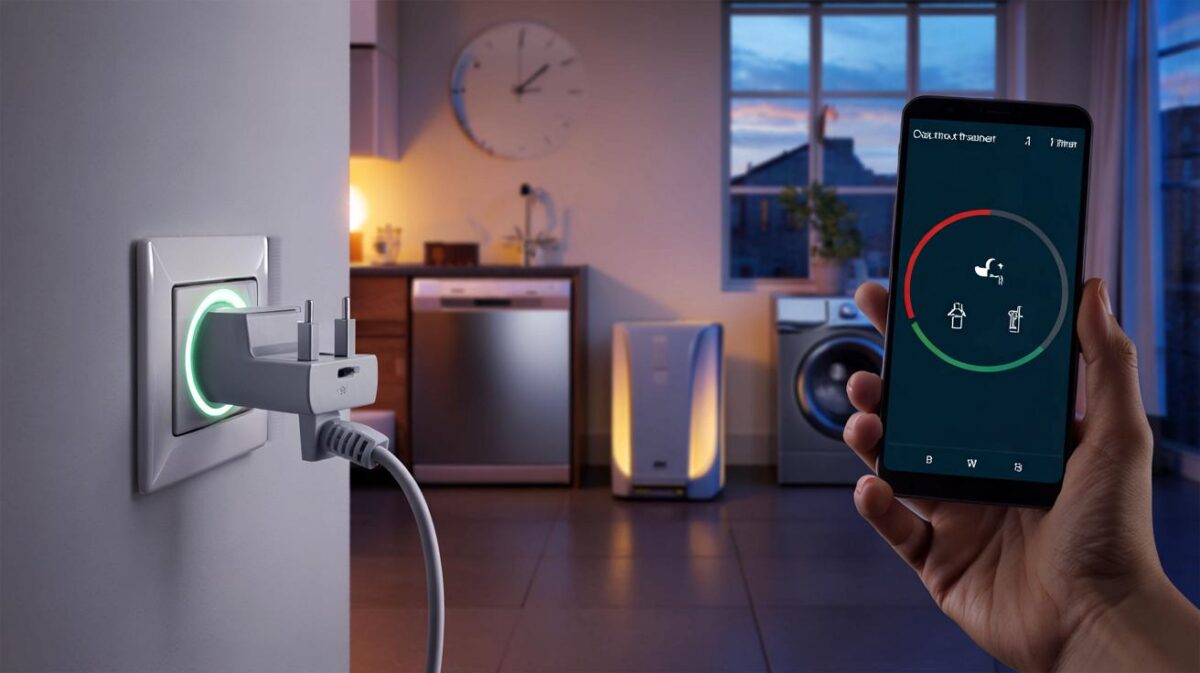Winter creeps under the skirting boards, and your heating bill looks smug. You’re either roasting in one room or layered up in another. Somewhere between those two extremes sits a small, surprisingly clever device: the smart radiator valve.
The kitchen was chilly, the hallway felt like a draught tunnel, and yet my home office was quietly climbing to 19°C, ready for emails and tea. No boiler blast, no fiddling with the old plastic cap. Just a soft motor whirr and a tiny display winking awake. We’ve all had that moment where a house feels like it has moods; that morning, mine felt attentive. It knew where I’d be, and it acted without fuss. A small decision, made on my behalf. Then it did something else.
What a smart radiator valve actually does
A smart radiator valve replaces the twisty bit on your radiator that you barely touch after October. It watches room temperature and nudges the flow of hot water into that radiator with more finesse than your hand ever could. In plain terms, it turns one big lump of heat into rooms that behave differently. The living room gets cosy for the film; the box room stays modest; the guest room goes quiet until someone actually uses it.
Here’s where it gets tangible. A family in Leeds swapped five old TRV heads for connected ones. Bedtime meant 17°C upstairs, 20°C in the lounge until 10pm, then a gentle fade. Their gas use dropped by a quarter against the previous winter, even with two extra work-from-home days. Vendor claims can be generous, sure, but *a one-degree drop across the home typically shaves around 10% off heating energy*. The trick is letting rooms be different on purpose, not by accident.
Smart valves do their best work as part of a system. On their own, they trim heat in each room when the boiler’s already running. Paired with a compatible hub and thermostat — think Tado, Drayton Wiser, Hive, Netatmo, Eve — they can also whisper to the boiler when to fire, which rooms actually need warmth, and at what flow temperature. That’s how you get true “zoned” heating without replumbing your house. It’s a layer of control on top of the pipes you already own.
Why they’re worth considering now
The standout move: start with the rooms that matter most. Bedrooms, the home office, the nursery. Fit smart valves where comfort is personal and time-bound. Create simple schedules that match real life — wake-up, work, school run, chill, sleep — and keep the defaults modest. 18–19°C is a good baseline for living spaces, a notch cooler for sleeping. Add a “boost” that runs for 30 minutes when someone presses the button, then steps back.
Let’s be honest: nobody manually tweaks every radiator twice a day. People rely on the hallway thermostat and hope for the best. That’s how you end up heating rooms you don’t use, or overshooting in the ones you do. Smart valves curb the waste at the radiator itself, which is exactly where the overshoot happens. If you’re renting, many swap straight onto existing TRV bodies with little more than an adaptor ring and two AA batteries. Reversible, quick, and no permission slip required.
There are a few traps worth dodging. Don’t bury valves behind thick radiator covers; they read the air wrong and chase phantom cold. Keep at least one radiator or an automatic bypass available so your boiler isn’t pushing against a closed circuit. If you’re on a heat pump, set gentle, longer schedules; steady warmth beats yo-yo peaks for efficiency. And calibrate each valve’s temperature offset once, so the number you see matches what you feel.
“Think of smart radiator valves like dimmers for heat,” says a veteran heating engineer I spoke to. “Lighting got smart one room at a time, and heating’s doing the same.”
- Good fit: WFH setups, nurseries, guest rooms, loft conversions.
- Less ideal: oversized radiators in tiny rooms that heat too fast without balancing.
- Watch-outs: weak Wi‑Fi in thick-walled houses; use a hub that reaches.
- Nice extras: open-window detection, child lock, holiday mode, voice control.
What it’s for, and who actually benefits
Smart radiator valves are for people who live in the real world of uneven days. Shift workers who sleep at noon. Parents with kids who kick off blankets at 3am. Remote workers chained to a desk in a drafty box room. They’re also for period homes where the front room bakes while the back room sulks. By sculpting heat around routines, you get comfort without blasting the entire system.
They’re a strong match for modern boilers and even better with weather-compensation or OpenTherm control, where the system can lower flow temperatures intelligently. Heat pumps benefit too, as long as you avoid fully closing too many radiators. The goal is slow, even heat, not a game of whack-a-mole. Periodically check that each room reaches setpoint at roughly the same pace; if not, a quick balancing tweak makes a big difference. Batteries typically last a year or two, and most apps warn you weeks in advance.
Cost-wise, the maths often stacks. A decent smart valve runs £40–£80 each, or less in bundles. If heating is half your energy spend, small room-by-room cuts add up fast across winter. Tado talks about up to 31% savings; independent figures vary, yet the direction is consistent. The more varied your routine, the more you gain. The beauty is emotional as much as financial: you walk into a room and it’s ready for you, not the other way round.
How to choose, fit, and live with them
Pick a platform that matches your future plans. If you’ll add a smart thermostat later, choose valves from the same ecosystem so the boiler listens to the rooms that shout. Look for quiet motors if you’re a light sleeper, and a clear display if the valve will be tucked under a sill. Most UK TRVs use the M30 x 1.5 thread, and good kits include adaptors for Danfoss and others. Fit one, test scheduling for a week, then roll out to the next room. It feels calmer that way.
Common mistakes come from treating every room the same. Don’t. Give bedrooms a cooler night profile and limit late-night boosts that fight sleep. Keep bathrooms warm only during the morning/evening rush. Allow cooler buffer zones — hallways, utility rooms — to avoid overheating the house by accident. Voice control is handy, but don’t rely on it for everything. A physical twist-to-boost wins when your hands are wet and you’re late for school.
Noise worries? Most modern valves are barely audible, a quick buzz during tiny adjustments. Temperature accuracy? Do a one-time check with a reliable thermometer and set the offset if needed. If your radiators clank or one room never gets warm, that’s a balancing job, not a smart-valve failure.
“Smart doesn’t fix bad plumbing, but it makes good plumbing sing,” says a homeowner who fitted eight valves in a draughty Victorian end-terrace.
- Start small: office + main bedroom for immediate impact.
- Set a 17°C night-time baseline and build comfort from there.
- Keep one radiator unrestricted or use an automatic bypass.
- Watch the app’s heat demand graph to spot problem rooms.
Where this all leads
Once you live with room-level control, going back feels blunt. The house stops being a single temperature and starts behaving like a place people actually inhabit. Morning routines get gentler. Evenings get cosier. Energy use nudges down without feeling punitive. There’s a quiet dignity to a room that’s warm because you walked into it, not because the clock said so two hours earlier. Smart valves won’t change the weather. They will change how your home responds to it, one radiator at a time.
| Key points | Detail | Reader Interest |
|---|---|---|
| Room-by-room control | Smart valves modulate each radiator for targeted comfort | Personalised heat without heating the whole house |
| Works with existing systems | Fits most TRVs; shines with a compatible hub/thermostat | Upgrade without replumbing or major expense |
| Real-world savings | Lower setpoints and schedules cut wasted heat | Lower bills and a calmer, cosier routine |
FAQ :
- Do smart radiator valves work without a smart thermostat?Yes. They control individual radiators when the heating is on. With a smart thermostat or hub, they can also request heat and coordinate the boiler.
- Will they fit my existing radiators?Most UK TRVs use M30 x 1.5 threads. Good kits include adaptors for common alternatives like Danfoss. Older non-TRV valves may need a plumber to swap the body.
- Can they save money in a small flat?Often, yes. Even two or three zones — living room, bedroom, office nook — reduce overshoot and stop heating unused space.
- Are they noisy at night?Modern models are quiet. You’ll hear a brief buzz during adjustments. If you’re sensitive, pick a low-noise model and avoid midnight schedule shifts in bedrooms.
- What about heat pumps?They play nicely. Use gentle, longer schedules and avoid shutting every radiator. Steady flow keeps efficiency high and rooms comfortable.








